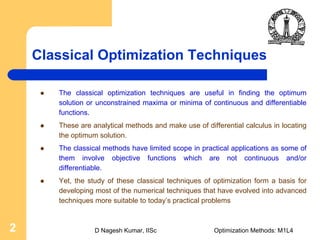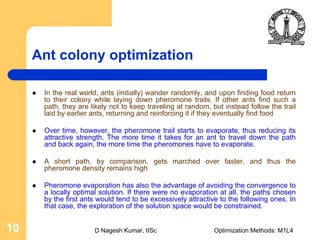Numerical analysis genetic algorithms
- 1. D Nagesh Kumar, IISc Optimization Methods: M1L41 Introduction and Basic Concepts Classical and Advanced Techniques for Optimization
- 2. D Nagesh Kumar, IISc Optimization Methods: M1L42 Classical Optimization Techniques The classical optimization techniques are useful in finding the optimum solution or unconstrained maxima or minima of continuous and differentiable functions. These are analytical methods and make use of differential calculus in locating the optimum solution. The classical methods have limited scope in practical applications as some of them involve objective functions which are not continuous and/or differentiable. Yet, the study of these classical techniques of optimization form a basis for developing most of the numerical techniques that have evolved into advanced techniques more suitable to today’s practical problems
- 3. D Nagesh Kumar, IISc Optimization Methods: M1L43 Classical Optimization Techniques (contd.) These methods assume that the function is differentiable twice with respect to the design variables and the derivatives are continuous. Three main types of problems can be handled by the classical optimization techniques: – single variable functions – multivariable functions with no constraints, – multivariable functions with both equality and inequality constraints. In problems with equality constraints the Lagrange multiplier method can be used. If the problem has inequality constraints, the Kuhn-Tucker conditions can be used to identify the optimum solution. These methods lead to a set of nonlinear simultaneous equations that may be difficult to solve. These methods of optimization are discussed in Module 2.
- 4. D Nagesh Kumar, IISc Optimization Methods: M1L44 Numerical Methods of Optimization Linear programming: studies the case in which the objective function f is linear and the set A is specified using only linear equalities and inequalities. (A is the design variable space) Integer programming: studies linear programs in which some or all variables are constrained to take on integer values. Quadratic programming: allows the objective function to have quadratic terms, while the set A must be specified with linear equalities and inequalities Nonlinear programming: studies the general case in which the objective function or the constraints or both contain nonlinear parts.
- 5. D Nagesh Kumar, IISc Optimization Methods: M1L45 Numerical Methods of Optimization (contd.) • Stochastic programming: studies the case in which some of the constraints depend on random variables. • Dynamic programming: studies the case in which the optimization strategy is based on splitting the problem into smaller sub-problems. • Combinatorial optimization: is concerned with problems where the set of feasible solutions is discrete or can be reduced to a discrete one. • Infinite-dimensional optimization: studies the case when the set of feasible solutions is a subset of an infinite-dimensional space, such as a space of functions. • Constraint satisfaction: studies the case in which the objective function f is constant (this is used in artificial intelligence, particularly in automated reasoning).
- 6. D Nagesh Kumar, IISc Optimization Methods: M1L46 Advanced Optimization Techniques Hill climbing: it is a graph search algorithm where the current path is extended with a successor node which is closer to the solution than the end of the current path. In simple hill climbing, the first closer node is chosen whereas in steepest ascent hill climbing all successors are compared and the closest to the solution is chosen. Both forms fail if there is no closer node. This may happen if there are local maxima in the search space which are not solutions. Hill climbing is used widely in artificial intelligence fields, for reaching a goal state from a starting node. Choice of next node/ starting node can be varied to give a number of related algorithms.
- 7. D Nagesh Kumar, IISc Optimization Methods: M1L47 Simulated annealing The name and inspiration come from annealing process in metallurgy, a technique involving heating and controlled cooling of a material to increase the size of its crystals and reduce their defects. – The heat causes the atoms to become unstuck from their initial positions (a local minimum of the internal energy) and wander randomly through states of higher energy; – the slow cooling gives them more chances of finding configurations with lower internal energy than the initial one. In the simulated annealing method, each point of the search space is compared to a state of some physical system, and the function to be minimized is interpreted as the internal energy of the system in that state. Therefore the goal is to bring the system, from an arbitrary initial state, to a state with the minimum possible energy.
- 8. D Nagesh Kumar, IISc Optimization Methods: M1L48 Genetic algorithms A genetic algorithm (GA) is a local search technique used to find approximate solutions to optimization and search problems. Genetic algorithms are a particular class of evolutionary algorithms that use techniques inspired by evolutionary biology such as inheritance, mutation, selection, and crossover (also called recombination).
- 9. D Nagesh Kumar, IISc Optimization Methods: M1L49 Genetic algorithms (contd.) Genetic algorithms are typically implemented as a computer simulation, in which a population of abstract representations (called chromosomes) of candidate solutions (called individuals) to an optimization problem, evolves toward better solutions. The evolution starts from a population of completely random individuals and occurs in generations. In each generation, the fitness of the whole population is evaluated, multiple individuals are stochastically selected from the current population (based on their fitness), and modified (mutated or recombined) to form a new population. The new population is then used in the next iteration of the algorithm.
- 10. D Nagesh Kumar, IISc Optimization Methods: M1L410 Ant colony optimization In the real world, ants (initially) wander randomly, and upon finding food return to their colony while laying down pheromone trails. If other ants find such a path, they are likely not to keep traveling at random, but instead follow the trail laid by earlier ants, returning and reinforcing it if they eventually find food Over time, however, the pheromone trail starts to evaporate, thus reducing its attractive strength. The more time it takes for an ant to travel down the path and back again, the more time the pheromones have to evaporate. A short path, by comparison, gets marched over faster, and thus the pheromone density remains high Pheromone evaporation has also the advantage of avoiding the convergence to a locally optimal solution. If there were no evaporation at all, the paths chosen by the first ants would tend to be excessively attractive to the following ones. In that case, the exploration of the solution space would be constrained.
- 11. D Nagesh Kumar, IISc Optimization Methods: M1L411 Ant colony optimization (contd.) Thus, when one ant finds a good (short) path from the colony to a food source, other ants are more likely to follow that path, and such positive feedback eventually leaves all the ants following a single path. The idea of the ant colony algorithm is to mimic this behavior with "simulated ants" walking around the search space representing the problem to be solved. Ant colony optimization algorithms have been used to produce near-optimal solutions to the traveling salesman problem. They have an advantage over simulated annealing and genetic algorithm approaches when the graph may change dynamically. The ant colony algorithm can be run continuously and can adapt to changes in real time. This is of interest in network routing and urban transportation systems.
- 12. D Nagesh Kumar, IISc Optimization Methods: M1L412 Thank You












